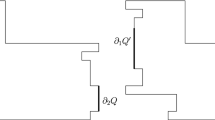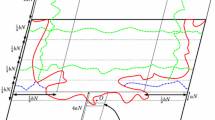Abstract
On the planar hexagonal lattice \(\mathbb{H}\), we analyze the Markov process whose state σ(t), in \(\{ - 1, + 1\} ^\mathbb{H} \), updates each site v asynchronously in continuous time t≥0, so that σ v (t) agrees with a majority of its (three) neighbors. The initial σ v (0)'s are i.i.d. with P[σ v (0)=+1]=p∈[0,1]. We study, both rigorously and by Monte Carlo simulation, the existence and nature of the percolation transition as t→∞ and p→1/2. Denoting by χ+(t,p) the expected size of the plus cluster containing the origin, we (1) prove that χ+(∞,1/2)=∞ and (2) study numerically critical exponents associated with the divergence of χ+(∞,p) as p↑1/2. A detailed finite-size scaling analysis suggests that the exponents γ and ν of this t=∞ (dependent) percolation model have the same values, 4/3 and 43/18, as standard two-dimensional independent percolation. We also present numerical evidence that the rate at which σ(t)→σ(∞) as t→∞ is exponential.
Similar content being viewed by others
REFERENCES
A. J. Bray, Theory of phase-ordering kinetics, Adv. Phys. 43:357-459 (1994).
T. M. Liggett, Interacting Particle Systems (Springer, New York, 1985).
F. Camia, C. M. Newman, and V. Sidoravicius, Approach to fixation for zero-temperature stochastic Ising models on the hexagonal lattice, in In and Out of Equilibrium: Probability with a Physics Flavor, V. Sidoravicius, ed. (Birkhäuser, Boston, 2002), pp. 163-183.
S. Nanda, C. M. Newman, and D. L. Stein, Dynamics of Ising spin systems at zero temperature, in On Dobrushin's Way (From Probability Theory to Statistical Physics), R. Minlos, S. Shlosman, and Y. Suhov, eds., Amer. Math. Society Transl. (2) 198:183-194 (2000).
H. Kesten, Percolation Theory for Mathematicians (Birkhäuser, Boston, 1982).
F. Camia, E. De Santis, and C. M. Newman, Clusters and recurrence in the two-dimensional zero-temperature stochastic Ising model, Ann. Appl. Probab. 12:565-580 (2002).
T. E. Harris, A correlation inequality for Markov processes in partially ordered state spaces, Ann. Probab. 5:451-454 (1977).
A. Gandolfi, M. Keane, and L. Russo, On the uniqueness of the infinite occupied cluster in dependent two-dimensional site percolation, Ann. Probab. 16:1147-1157 (1988).
M. P. M. den Nijs, A relation between the temperature exponents of the eight-vertex and q‐state Potts model, J. Phys. A: Math. Gen. 12:1857-1868 (1979).
B. Nienhuis, E. K. Riedel, and M. Schick, Magnetic exponents of the two dimensional q‐state Potts model, J. Phys. A: Math. Gen. 13:L189-L192 (1980).
R. P. Pearson, Conjecture for the extended Potts model magnetic eigenvalue, Phys. Rev. B 22:2579-2580 (1980).
G. Grimmett, Percolation (Springer, Berlin, 1999).
L. Russo, A note on percolation, Z. Wahrsch. Verw. Gebiete 43:39-48 (1987).
H. Saleur and B. Derrida, A combination of Monte Carlo and transfer matrix methods to study 2d and 3d percolation, J. Physique 46:1043-1057 (1985).
M. N. Barber, Finite size scaling, in Phase Transitions and Critical Phenomena, Vol. 8, C. Domb and J. L. Lebowitz, eds. (Academic, London, 1983), pp. 146-266.
J. L. Cardy, ed., Finite-Size Scaling (North-Holland, Amsterdam, 1988).
V. Privman, ed., Finite Size Scaling and Numerical Simulation of Statistical Systems (World Scientific, Singapore, 1990).
C. D. Howard, Zero-temperature Ising spin dynamics on the homogeneous tree of degree three, J. Appl. Probab. 37:736-747 (2000).
C. M. Newman and D. L. Stein, Blocking and persistence in the zero-temperature dynamics of homogeneous and disordered Ising models, Phys. Rev. Lett. 82:3944-3947 (1999).
L. R. Fontes, R. H. Schonmann, and V. Sidoravicius, Stretched exponential fixation in stochastic Ising models at zero temperature, Commun. Math. Phys. 228:495-518 (2002).
Author information
Authors and Affiliations
Rights and permissions
About this article
Cite this article
Howard, C.D., Newman, C.M. The Percolation Transition for the Zero-Temperature Stochastic Ising Model on the Hexagonal Lattice. Journal of Statistical Physics 111, 57–62 (2003). https://doi.org/10.1023/A:1022296706006
Issue Date:
DOI: https://doi.org/10.1023/A:1022296706006




